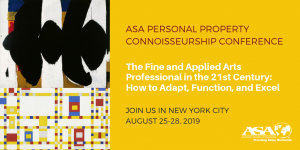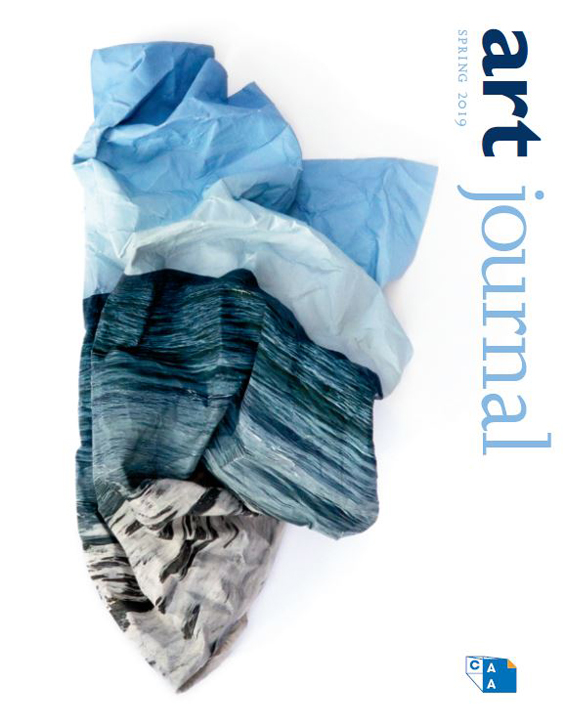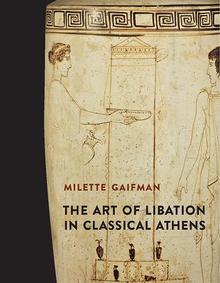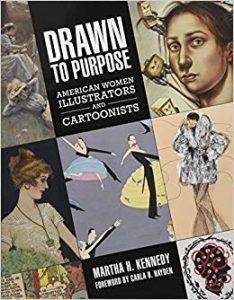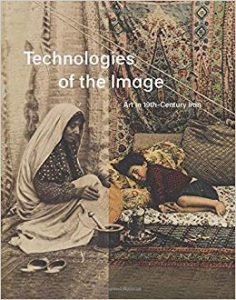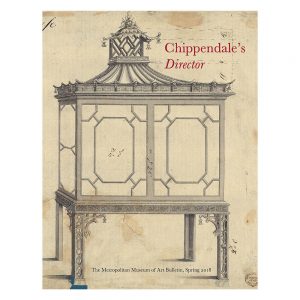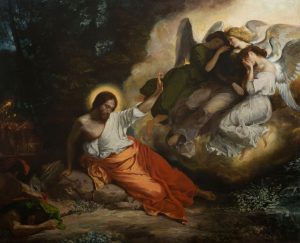CAA News Today
CAA Announces Inaugural Recipients of the Art History Fund for Travel to Special Exhibitions
posted by CAA — Jun 19, 2019
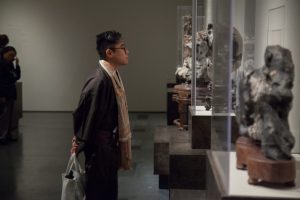
2018 CAA Annual Conference. Photo: Rafael Cardenas
In fall 2018, we announced CAA had received an anonymous gift of $1 million to fund travel for art history faculty and their students to special exhibitions related to their classwork. The generous gift established the Art History Fund for Travel to Special Exhibitions.
The jury for the Art History Fund for Travel to Special Exhibitions met in May 2019 to select the first group of recipients as part of the gift.
The awardees are:
Catherine Girard, Eastern Washington University
Class: Topics in Art History: Manet Inside Out
Exhibition: Manet and Modern Beauty at The J. Paul Getty Museum, Los Angeles
Luis Gordo Peláez, California State University Fresno
Class: Arts of the Colonial Andes
Exhibition: Art & Empire: The Golden Age of Spain at The San Diego Museum of Art
Alison Miller, University of the South
Class: Japanese Print Culture
Exhibition: Yoshitoshi: Spirit and Spectacle at the Minneapolis Institute of Art
Rachel Stephens, University of Alabama
Class: American Portraiture
Exhibition: Black Out: Silhouettes Then and Now at the Birmingham Museum of Art
“We’re delighted to announce the inaugural recipients of the Art History Fund for Travel to Special Exhibitions, a groundbreaking CAA program designed specifically to enhance students’ first-hand knowledge of works of art,” said Hunter O’Hanian, CAA’s executive director. “The new Fund places a spotlight on the critical work art history scholars are doing to grow the field, with CAA as the go-to organization supporting and advancing their work.”
The Art History Fund for Travel to Special Exhibitions supports travel, lodging, and research efforts by art history students and faculty in conjunction with special museum exhibitions in the United States and throughout the world. Awards are made exclusively to support travel to exhibitions that directly correspond to the class content, and exhibitions on all artists, periods, and areas of art history are eligible.
Applications for the second round of grants will be accepted by CAA beginning in fall 2019. Deadlines and details can be found on the Travel Grants page.
Announcing the Recipients of the 2019 Spring Millard Meiss Publication Fund Awards
posted by CAA — Jun 13, 2019
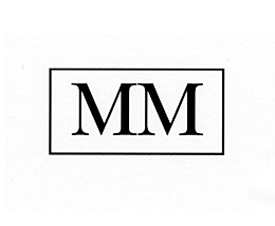
The Millard Meiss Publication Fund is made possible by a generous bequest of the late Prof. Millard Meiss. Two times each year, CAA awards grants to publishers in art history and visual culture to support presses in the publication of projects of the highest scholarly and intellectual merit that may not generate adequate financial return.
The Meiss grantees for spring 2019 are:
Bajorek, Jennifer, Unfixed: Photography and Decolonial Imagination in West Africa, Duke University Press, 2019.
Busbea, Larry, The Responsive Environment: Design, Aesthetics, and the Human in the 1970s, University of Minnesota Press, 2019.
Fozi, Shirin, Romanesque Tomb Effigies: Death and Redemption in Medieval Europe, 1000-1200, Penn State University Press, 2020.
Guinness, Katherine, Schizogenesis: The Art of Rosemarie Trockel, University of Minnesota Press, 2019.
Naoi, Nozomi, Beyond the Modern Beauty: Takehisa Yumeji and the New Mediascape of Early Twentieth-Century Japan, University of Washington Press, 2019.
Newbury, Susanna, Speculations: Art, Real Estate, and the Making of Global Los Angeles, University of Minnesota Press, 2020.
Overton, Keelan, Iran and the Deccan: Persianate Art, Culture, and Talent in Circulation, 1400-1700, Indiana University Press, 2020.
Schwartz, Vanessa R., Jet Age Aesthetic: The Glamour of Media in Motion, Yale University Press, 2020.
Sichel, Kim, Making Strange: The Modernist Photobook in France, Yale University Press, 2020.
Silberstein, Rachel, Embroidered Figures: Fashion and Commerce in Nineteenth-Century China, University of Washington Press, 2020.
VanDiver, Rebecca, Negotiating Traditions: Loïs Mailou Jones and the Composite Aesthetics of Blackness, Penn State University Press, 2020.
Zinman, Gregory Austen, Making Images Move: Handmade Cinema and the Other Arts, University of California Press, 2020.
Learn more about the Millard Meiss Publication Fund.
Affiliated Society News for June 2019
posted by CAA — Jun 06, 2019
Affiliated Society News shares the new and exciting things CAA’s affiliated organizations are working on including activities, awards, publications, conferences, and exhibitions.
Interested in becoming an Affiliated Society? Learn more here.
American Society of Appraisers
The 2019 ASA Personal Property Connoisseurship Conference – NY will be held at the Marriott Marquis centered in the heart of New York City. With a focus on The Fine and Applied Arts Professional in the 21st Century: How to Adapt, Function and Excel, this intensive three-day conference will provide hard-to-obtain insights into key topics and issues facing personal property appraisers and other art industry professionals. Connect with experts, scholars, and allied professionals from across North America. Presenting speakers include individuals from the industry media, specialty auction houses, galleries, museums, and academia, among others. Register here: http://www.appraisers.org/Education/conferences/personal-property-conference
Association of Art Museum Curators (AAMC)
ASSOCIATION OF ART MUSEUM CURATORS FOUNDATION
Join us this June for a series of three webinars that will restructure and rethink how we consider the topic of management. By focusing on Navigation, Environment and Advancement, the webinars will break with the traditional hierarchical and vertical manner in which conversations around management are typically approached. Each program will present dialogues relevant to all career stages, and will consider ways in which the topic can impact sense of self, well-being, and personal success.
Webinar 1: Navigation – June 11, 2019
Webinar 2: Environment – June 18, 2019
Webinar 3: Advancement – June 25, 2019
Organized and hosted by the AAMC Foundation the series is open to all, with AAMC members receiving discount admission. Limited space is available, register today!
ASSOCIATION OF ART MUSEUM CURATORS (AAMC) & AAMC FOUNDATION
AAMC members are invited to Submit a Session Proposal for the 2020 AAMC & AAMC Foundation Conference, slated for May 2 – 5, 2020 in Seattle, WA. We are seeking proposals on the topic of advancing curatorial work and art organizations beyond traditional and perceived thresholds and boundaries. In selecting this topic, we anticipate dialogues reconsidering linear narratives, challenging concepts of borders, investigating social and cross cultural interactions, and engaging in activism.
We request proposals considering the full spectrum of interpretations, looking at possible topics holistically and not solely through the curatorial lens. Sessions should propose discussions acknowledging community, which involves our workplace colleagues and partners; donors and sponsors; visitors and neighbors; for-profit arts sector; and more. As with all our programming, the proposals should be inclusive and welcoming of a diverse audience. Review the full guidelines and submit your session proposal before 5PM ET on Monday, June 24, 2019.
ASSOCIATION OF ART MUSEUM CURATORS FOUNDATION
Applications are open for AAMC Foundation’s Mentorship Program, which gives early- to mid-career curators opportunities to advance their professional development, learn about important issues in the field, share ideas and cultivate strong bonds with peers, and develop a working relationship with a senior curator. The program’s goal is to advance the skills, experience and knowledge needed to succeed in a curatorial career, not specifically develop a singular curatorial or scholarly project. All Mentees are provided funding to accommodate program components, including travel and other benefits, which are outlined in greater detail here. A group of curator jurors will select ten mentees for 2019-2020 Program, with Mentees and Mentors announced this July.
Applications are due by 12PM ET on Tuesday, June, 25, 2019. Click here to learn more and submit your application today!
Association for Latin American Art (ALAA)
ALAA Awards
In addition to the annual book award, ALAA announces two new awards. See the links for details.
ALAA-Arvey Foundation Book Award
ALAA-Arvey Foundation Exhibition Catalogue Award
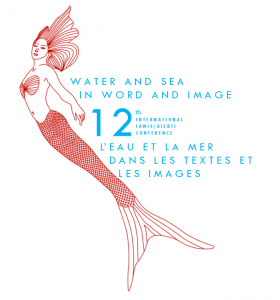
International Association of Word and Image Studies (IAWIS)
CFP for the 2020 Conference in Luxembourg: https://waterandsea2020.uni.lu/program/
American Institute for Conservation
Following a successful Annual Meeting in Connecticut, we are looking forward to our 2020 Annual Meeting in Salt Lake City! The theme will be “Conservation – Reactive and Proactive.” The call for papers will open later this summer, please continue to check our site for updated information.
If you are interested in learning more about conservation and supporting the essential work performed by conservators and preservation professionals, become a Friend of Conservation! Friends receive exclusive insights into conservation, including tips on preserving personal collections, and sustain key programs that promote the preservation of all cultural heritage. Learn about the benefits of being a Friend and how you can help save the art and artifacts that keep our memories alive. Support the Foundation for Advancement in Conservation through www.culturalheritage.org/friends.
International Sculpture Center
Sculpture magazine is thrilled to announce its new website. Go to www.sculpturemagazine.art for reviews, features, news, videos, and other daily content.
Attend workshops, studio tours, and network with artists at the 29th International Sculpture Conference in Portland, OR. Registration opens June 11th at www.sculpture.org/portland19.
Society of Architectural Historians
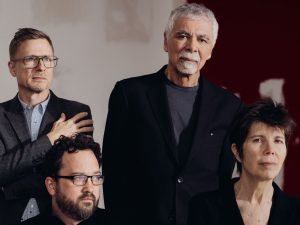
Photo: Geordie Wood, courtesy of DS+R
The Society of Architectural Historians will present the inaugural SAH Change Agent Award to the partners of the New York architecture firm Diller Scofidio + Renfro—Elizabeth Diller, Ricardo Scofidio, Charles Renfro and Benjamin Gilmartin—at a reception at the Century Club in midtown Manhattan on July 17. The award recognizes DS+R for their innovative, paradigm-shifting work, which takes an interdisciplinary approach to design with a focus on cultural and civic projects. Proceeds benefit SAH educational programs and publications, and the ongoing restoration SAH’s landmark headquarters, Charnley-Persky House (1891–1892), designed by Adler and Sullivan with Frank Lloyd Wright.
Nominations for the SAH Publication Awards and the SAH Award for Film and Video are open through July 31. The Publication Awards recognize the most distinguished publications in architectural history, urban history, landscape history, preservation, and architectural exhibition catalogues. The SAH Award for Film and Video was established in 2013 to recognize annually the most distinguished work of film or video on the history of the built environment.
The SAH Board of Directors seeks nominations for the 2020 class of SAH Fellows, those professionally active or retired individuals who have distinguished themselves by a lifetime of significant contributions to the field of architectural history. Deadline August 1.
The SAH Nominating Committee seeks your nominations for five new SAH Board members and a Second Vice President who will begin their terms after the Seattle annual conference in April/May 2020. Deadline August 1.
Graduate students and emerging scholars are invited to apply for the SAH Study Program Fellowship to attend the SAH Field Seminar to Japan, December 6–18. The tour will be led by Ken Tadashi Oshima. The fellowship covers the single occupancy price of the tour and includes a travel stipend. Deadline August 2.
SECAC
On behalf of the SECAC Nominating Committee, First Vice-President Lawrence Jenkens announced that the 2019 SECAC election results have been finalized. The following members have been elected to the SECAC Board of Directors for a three-year term of appointment. For Arkansas, Dito Morales, Associate Professor of Art History at the University of Central Arkansas, was re-elected to a second term. For Florida, Jeff Schwartz, Dean of Undergraduate Studies and Associate Vice-President of Academic Affairs at Ringling College of Art and Design was elected to his first term. For Mississippi, Elise Smith, Professor of Art History and Sanderson Chair of Arts and Sciences at Millsaps College in Jackson, Mississippi, was elected to her first term. Smith previously served on the SECAC Board of Directors from 2000 to 2006. For Tennessee, Christina Renfer Vogel, Assistant Professor of Painting and Drawing at the University of Tennessee at Chattanooga and 2019 SECAC Conference Co-Director, was elected to her first term. For the First At-large Seat, Dennis Ichiyama, Purdue Univeristy Professor of Graphic Design emeritus, was re-elected to a second term. The SECAC Nominating Committee thanks all members who ran for Board seats this year.
Association of Greek Art Historians (EEIT)
The Association of Greek Art Historians (EEIT) hosted a number of distinguished speakers in the context of its 2019 Lecture Series. The aim of the series is to engage a broader audience and promote the discipline of art history in the wider public sphere in Greece. The topics ranged from global art history to the art of the periphery, addressing theoretical and methodological issues of contemporary relevance. Concurrently, novel interpretations of modernism were proposed from the vantage points of both the center, a eurocentric perspective, and the periphery, the lens of the ‘european other.’ James Elkins, E.C. Chadbourne Professor at the School of the Art Institute of Chicago, talked about the “The End of Diversity in Writing about Art” (January 11, 2019, Benaki Museum, 138 Pireos St., Athens, Greece). Elkins proposed that despite recent interest in global artistic production, writing about art is primarily characterized by a hegemony of western theoretical discourses and related practices. Mark Crinson provided an enhanced reading of modernist architecture through the ideals of internationalism in a lecture entitled “Babel as Modernism” (April 11, 2019, Athens School of Fine Arts, Athens, Greece). Mark Crinson is professor of architectural history at Birbeck, University of London and president of the European Architectural History Network (EAHN). Matthew Rampley shared initial thoughts and material related to the European Research Grant project Continuity / Rupture: Art and Architecture in Central Europe 1918-1939 that he is currently leading from Masaryk University in Brno in the Czech Republic. The lecture was entitled “A Legacy of Empire? Art and Architecture in Central Europe after 1918” and examined how ‘modernist’ art was deployed in Central Europe to create and enforce national identities at the aftermath of the collapse of the Habsburg Empire after the First World War. (May 17, 2019, National Hellenic Research Foundation, Athens, Greece).
Design Incubation
Calls for Participation: Design Incubation Upcoming Events
Call for Entries: 2019 Communication Design Educators Awards
An international juried competition of communication design research, practice, teaching, and service. Expand the design record, promote excellence, and share knowledge in the discipline. Submit your creative work, published research, teaching, and service. Nominations are accepted until July 31, 2019. Entries are currently being accepted until August 31, 2019.
Visit the 2019 Design Incubation Communication Design Educators Awards announcement to read about our distinguished jurors.
Colloquium 6.1: Quinnipiac University, Call for Submissions
Call for design research presentation abstracts. Deadline: Saturday, July 6, 2019. Hosted by Courtney Marchese and the School of Communications.
School of Communications
Quinnipiac University
Sat, October 5, 2019
10:00 AM – 5:30 PM
A Day of Writing
Come spend an uninterrupted day working on a writing project. Participants will spend the day writing or conducting preliminary work on a writing project. The Day of Writing is open to design faculty and to those working in related fields.
Quinnipiac University
October 6th 2019
10:00am –4:00pm
The Design Incubation Residency at Haddon Avenue Writing Institute 2019
Rolling acceptances until Sept 30, 2019. Only 14 seats are available for this event. This 3-day residency allows researchers and scholars time to work on existing writing projects or to start a new writing project. It offers participants concentrated time to work on writing projects and the opportunity to take advantage of one-on-one consultations with event facilitator Maggie Taft.
Haddon Avenue Writing Institute
2009 W. Haddon Ave, Chicago Illinois
October 25-27, 2019
Visual Resources Association
Approximately 200 information professionals gathered in LA’s Little Tokyo for the VRA conference from March 26-29, 2019: http://www.vraweb.org/conferences/vra2019/. Many conference presentations have been uploaded to SlideShare at https://www.slideshare.net/VisResAssoc and photographs from the events can be found at https://www.flickr.com/groups/vra_events/. The VRA’s journal of professional practice is expecting articles based on conference presentations to be in the June issue of the VRA Bulletin, which is now an open access online journal, see: https://online.vraweb.org/vrab/
Visual Resources Association (VRA) is a multidisciplinary organization dedicated to furthering research and education in the field of image management within the educational, cultural heritage, and commercial environments. For more information on VRA: http://vraweb.org/.
Call for Proposals
The Visual Resources Association’s 2020 Annual Conference will be held in Baltimore, Maryland from Tuesday, March 24th through Friday, March 27th, 2020 at the Royal Sonesta Harbor Court Baltimore.
Presenting at the VRA Conference provides you with the opportunity to see how your ideas, research, work, and passion connect to those of other dedicated professionals while building networks and friendships in an open, collaborative environment.
Click here to access the conference proposal form.
The VRA Executive Board is soliciting proposals for papers, sessions, special interest/user groups, and workshops for the 2020 program until Friday, July 19th. All proposals are welcome, and if you have other conference ideas or suggestions that do not fit the conference proposal form, please reach out to the Vice President for Conference Program, Sara Schumacher. Please note a call for Lightning Round presenters will go out in the fall/winter, so that we can better accommodate recent innovations and activities, as well as, students and emerging professionals.
A paper is an individual idea submission, which will be reviewed for possible grouping into a session. Your ideas, whether they come to us alone or in a group, are equally valued in the Board’s proposal and selection process.
- A session is a maximum 60-minute moderated panel, usually consisting of no more than 3 presenters each, speaking for 15 to 18 minutes, followed by a brief facilitated question and answer period. If you feel your session topic requires more time, consider dividing it into two sessions, consisting of a Part I and a Part II.
- A special interest/user group is a 60-minute informal, community -driven, facilitated group discussion on topics related to a specific segment of the VRA membership.
- A workshop is a 2, 4, or 8-hour workshop to develop skills and experience in the field of visual resources with hands-on activities.
What should you propose?
Past conference schedules can give you an idea of the range of topics presented in previous years or read through the list below of suggested topics compiled from the 2019 post-conference survey responses to find inspiration. Please, do not be afraid to deviate and propose something new or highlight an area of concern that you feel has not been adequately addressed previously, as you may find new collaborators and colleagues. Moderators may put out calls for presenters within a proposed topic before or after the submission of a proposal. The VRA Executive Board will be looking for articulate and concise submissions with lists of presenters, but submissions without presenter lists are encouraged as well.
Suggested topics:
- Coding (PHP, Python, SQL, etc.)
- Community Outreach
- Copyright/Intellectual Property
- Digital Asset Management, Digital Curation, Digital Preservation, etc.
- Digitization (Workflows, Digital Capture and Imaging Technologies)
- Digital Scholarship and Digital Humanities
- Diversity, Equity, Inclusion, Cultural Competencies, Social Justice
- Project Management (Communication, Grant writing, Prioritization, Leadership, etc.)
- Linked Data
- Materials/Objects collections
- Metadata/Cataloging Ethics (Decolonizing vocabularies, Radical cataloging)
- Storytelling and Oral History
- Technologies (GIS and mapping, 3D imaging, etc.)
- Tools: Open Source, Evolution, Future Trends
- Workplace cultures and professional transitions (academic departments, libraries, cultural heritage institutions, archives, corporate, etc.)
Please contact the Vice President for Conference Program, Sara Schumacher at vpcp@vraweb.org with any questions or concerns.
Again, the proposal deadline is Friday, July 19th, 2019. Click here to access the conference proposal form.
Association for Textual Scholarship (ATSAH)
Members’ Publications and Events May 2019
Publications
Bosch, Lynette M.F. Demi. Skira Publishers, 2019.
Bosch, Lynette M.F. ” The Cuban-American Exile Vanguardia: Towards a Theory of Collecting Cuban-American Art, ” Picturing Cuba: Art, Culture and Identity on the Island and the Diaspora. University of Florida Press, 2019.
Bosch, Lynette M.F “Before 1962: Mannerism and Historiography,” Renaissance Society of America Annual Conference, Toronto, Canada (2019).
Bosch, Lynette M.F. Curator, SUNY Geneseo, “Cuban-American Art and Cultural Identity,” April 3-May 4, 2019
Bosch, Lynette M.F. Curator, Binghmaton University, “Visions and Imagination: Cuban-American and Argentinian Art,” January 31-March 14, 2019.
Carrara, Eliana “Vasari e Ammannati nel Cantiere della Villa Medicea di Castello: Due Disegni del Metropolitan Museum of Art in New York,” in Opus Incertum (2018) pp. 44-53 | ISSN 2239-5660 (print) ISSN 2035-9217 (online) ; DOI: 10.13128/opus-23045 www.fupress.com/oi, pp. 44-53.
Cheney, Liana De Girolami, ““Edward Burne-Jones’s The Mirror of Venus: Physical and Intangible Female Beauty,” Journal of Literature and Art Studies, Vol. 19, No. 1 (January 2019):98-122.
Cheney, Liana De Girolami, “An Alchemical Heaven: The Studiolo Ceiling of Francesco I de’ Medici,” in Esotericism in Europe, ed. Lilian Zirpolo. Ramsey, NJ: Zephyrus Scholarly Publications, 2019, pp. 21-52.
Cheney, Liana De Girolami, “Giorgio Vasari’s Celestial Utopia of Whimsy and Joy: Constellations, Zodiac Signs and Grotesques,” Journal of Cultural and Religious Studies, Vol. 7, No. 1 (January 2019):1-31.Levin, William R. (Centre College, emeritus) has published online the entry for Jacobs Hall, the mid-19th-century
Italianate centerpiece of the Kentucky School for the Deaf in Danville, Kentucky, in the Society of Architectural Historians’ SAH Archipedia Classic Buildings (http://sah-archipedia.org/buildings/KY-01-021-0035). This ongoing national project, issued by the University of Virginia Press, provides detailed information on and photographs of the 100 most important structures in each state in an attractive and easy-to-use format equipped with abundant cross-referencing tools. An illustrated booklet by the author, published in 2014, contains expanded historical and architectural information on Jacobs Hall.
Levin, William R. “Jacobs Hall, Danville, Kentucky.” In SAH Archipedia Classic Buildings. Charlottesville: University of Virginia Press for the Society of Architectural Historians, Chicago, 2017. http://sah-archipedia.org/buildings/KY-01-021-0035.
Levin, William R. “The Bigallo Triptych: A Document of Confraternal Charity in Fourteenth-Century Florence.” Confraternitas 29, no. 1 (Spring 2018): 55-101.
Levin, William R. “Art as Confraternal Documentation: Homeless Children and the Florentine Misericordia in the Trecento.” In A Companion to Medieval and Early Modern Confraternities, edited by Konrad Eisenbichler, 433-457. Brill’s Companions to the Christian Tradition, vol. 83. Leiden, The Netherlands: Koninklijke Brill NV, 2019.
Passignat, É. Traductions, transferts méthodologiques et construction d’une histoire de l’art internationale: quelques cas français et italiens, in « Dire presque la même chose ». L’histoire de l’art et ses traductions (XIXe-XXIe siècles), eds. Adriana Sotropa and Myriam Metayer, Rennes, PUR, 2019: 121-138.
Passignat, É. La sculpture encadrée. Observations sur l’encadrement dans les ensembles sculptés italiens du XVIe siècle, in Jeux et enjeux du cadre dans les systèmes décoratifs à l’époque moderne, edited by Nicolas Cordon et alii, Rennes, PUR (June 2019).
Passignat, É. Book review of: Elisabetta Calderoni, Raccontare gli Antichi. Le Imagini di Vincenzo Cartari [premessa di B. Basile, Ariccia, Aracne editrice, 2017] Giornale storico della letteratura italiana (CXCVI, anno 2019, Fasc. 654 – 2° trimestre).
Passignat, É. Giorgio Vasari, Vita di Pierino da Vinci, scultore, commented by É. Passignat, in G. Vasari, Le vite de’ più eccellenti pittori, scultori e architettori, critical edition by Enrico Mattioda, Alessandria, Edizioni dell’Orso, Volume 4, forthcoming [Fall 2019].
Passignat, É., Giorgio Vasari, Vita di Cristofano Gherardi, detto Doceno, dal Borgo San Sepolcro, pittore, commented by É. Passignat, in G. Vasari, Le vite de’ più eccellenti pittori, scultori e architettori, critical edition directed by Enrico Mattioda, Alessandria, Edizioni dell’Orso, Volume 4, [Fall 2019].
Ricci, Patricia Likos, Professor of the History of Art and Director of the Fine Arts Department at Elizabethtown College presented the paper “On the Englishness of the American Renaissance” at Society of Architectural Historians 72nd International Conference, Providence, Rhode Island, in 2019.
Ricci, Patricia Likos published “The Inquiring Eye: Scientific Illustration and the Production of Knowledge,” a chapter in A Companion to Illustration (Blackwell, 2019).
Awards and Recognition
ATSAH Scholar Committee Awarded to Dr. Damiano Acciarino of the Università di Ca’Foscari Venezia and University of Toronto, Canada, the 2019 ATSAH Scholar Grant for outstanding research on Renaissance antiquarianism published in Lettere sulle Grottesche (Rome: Aracne, 2018).
Liana De Girolami Cheney was awarded the Albert Nelson Marquis Lifetime Achievement Award.
Additional Board to ATSAH
ATSAH announces a new Editorial Board
Damiano Acciarino, Università Ca’ Foscari Venezia
Pino Cascione, Università di Ado Moro, Bari, Italy
Karen Goodchild, Wofford College
Brian Steele, Texas Tech University
Katherine Powers, Fullerton University
Emilie Passignat, Independent Scholar, Florence
Lynette M.F. Bosch, State University of New York-Geneseo
Charles Burroughs, State University of New York-Geneseo
Andrzej Piotrowski, University of Minnesota
Yael Even, University of Missouri, St. Louis
In Memoriam
Sarah Jordan Lippert (1975-2019), Associate Professor of Art History at the University of Michigan-Flint, Director of the Society for Paragone Studies, Editor-in-Chief of its journal Paragone: Past and Present passed away on April 24, 2019. She was the author of numerous books and articles including the newly published The Paragone in Nineteenth-Century Art (Routledge 2019), along with Going Back to the Beginning of Things: The Ancient Origins of the Arts of France (Taylor and Francis, UK 2018), and The Temporality of Imitation in the Works of Moreau and Gérome (Tauris, UK, 2017): https://umflint.academia.edu/SarahLippert/Books
An Interview with Jordana Moore Saggese, Editor-in-Chief of Art Journal
posted by CAA — May 21, 2019

Photo by Sarah Deragon, Portraits to the People
Jordana Moore Saggese is an Associate Professor of American Art at the University of Maryland, College Park and the current Editor-in-Chief of Art Journal, CAA’s publication focused on twentieth- and twenty-first-century art history. Trained as an art historian, Saggese’s work focuses on modern and contemporary art with an emphasis on the expressions and theorizations of blackness. She was previously Associate Professor of Contemporary Art & Theory at California College of the Arts.
Joelle Te Paske, CAA Media and Content Manager, corresponded with her this month to learn about how she came to do the work she does, and her aspirations for the journal and the field beyond.
Joelle Te Paske: Thanks for taking the time for our interview, Jordana. So to begin, where are you from originally? What pathways led you to the work you’re doing now?
Jordana Moore Saggese: I am originally from Nashville, Tennessee. I attended Vanderbilt University, as a first-generation college student, for my undergraduate degree, and fell into an art history major at the very last moment. In fact, the summer before my senior year I suddenly realized that every opportunity I had to take an elective unit during my time at Vanderbilt I had chosen an art history class. The art history classes I took with my mentor Leonard Folgarait were truly inspiring. He encouraged his students (even those like me, who had very little knowledge of art history) to consider the work of artists as a response to the values and ideas of society, which in turn are determined by historical conditions. I can still remember his lecture on Dada, which was really the turning point for me. It was at that moment that I realized art was not something meant only for the elite; art could also be a form of rebellion. Although I had never been inside an art museum before my time as an undergraduate, Dr. Folgarait, and other faculty there, encouraged me and asked me to think deeply about the stakes of representation and introduced me to a range of objects across multiple continents and chronologies. With their encouragement, I decided to declare a major in art history and apply for graduate school my senior year.
This meant that I had to take the two-semester survey course as a senior, which fundamentally shifted the way I think about teaching those courses.
I can still remember my shock, sitting in a huge lecture hall, listening to someone drone on about a mostly white, male, heterosexist art history. I was wholly unprepared to memorize a seemingly endless stream of images. I finished the courses but this was not the art history that I was used to. That experience, of coming in almost backwards to the discipline, highlighted two main issues that still impact my teaching and research today.
First, how can we give students the very best introduction to the discipline—one that reflects the deep inquiry and the collaboration that was so intrinsic to my experience in the upper-division courses?
And second, whose art history are we teaching? That is, to what extent has a colonialist logic pervaded much of modern art history and what can I do—in my teaching and research—to undo that logic? I have been acutely aware of the ways in which art history has tended to exclude diverse perspectives and histories and much of my own work involves complicating those dominant narratives.
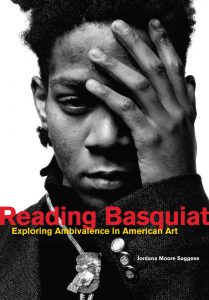
Saggese’s first book, Reading Basquiat: Exploring Ambivalence in American Art, was published by UC Press in 2014.
JTP: I love these questions as a fundamental starting point—not supplement—to the question of teaching art history. You were previously on the faculty at the California College of the Arts, and are now at University of Maryland, College Park. How has the transition been?
JMS: Teaching at an art school for the first ten years of my career was a wonderful experience in that it gave me direct and constant access to working artists. Thanks to my colleagues I was able to stay current in the field—a challenge for any historian of contemporary art—and my students constantly challenged me to make the history of art come into real time and space. CCA was also a site of experimentation, where students and faculty were willing to challenge one another, to wrestle openly with difficulty, and to fail. I have tried to bring those values to my teaching at Maryland as well. I have found the students and faculty at College Park to be deeply invested in their individual fields of interest but also in the discipline as a whole. There has also been tremendous support for my research practice, which has been a great benefit to making this transition.
JTP: As a Basquiat scholar, what is something you wish more people know about the artist?
JMS: I wish that more people considered the extent to which Basquiat’s celebrity status has threatened to eclipse his critical significance. My main project has been, and continues to be, writing this artist into the history of American art. I would also add that working on Basquiat presents extreme challenges for a researcher. There is no public archive of his work and approximately 85-90% of the paintings and drawings are in private collections (and I might mention, constantly being sold). This means that in order to see the works, one must shake a lot of hands, charm a lot of people, and knock on lots of doors. Working on Basquiat requires a thick skin, as I am often embroiled in territorial battles or even ignored. I also spend a lot of money traveling to see exhibitions so that I might glimpse the works in person. So, it’s not your typical research project!
JTP: I can only imagine the challenges that presents in pushing research forward—it’s far from a straightforward dive into the archives. What are you working on currently?
JMS: My second book, The Basquiat Reader: A Critical Anthology will be published by the University of California Press in 2020. The Basquiat Reader is a comprehensive sourcebook on Basquiat for both general audiences and advanced readers. Through a combination of interviews with the artist, criticism from the artist’s lifetime and immediately after, previously unpublished research by me, and a selection of the most important critical essays on the artist’s work, The Basquiat Reader provides a full picture of the artist’s views on art and culture, his working process, as well as the critical significance of his work both then and now. It is my hope that by giving more people access to the primary sources, we will see more scholarship on this artist.
My new book project considers representations of black male athletes as a point of entry to thinking about how black men have historically been presented to (and positioned by) the white mainstream public as a fear/fantasy. More specifically, I examine the ways in which black masculinity is constructed in the visual realm, and how the black athletic body can shape the moral, physical, and social position of African American men more broadly. Over five chapters I analyze key moments in the history of the sport, prominent black athletes and their representation in the American popular press and visual art.
JTP: That is such important work, especially as those constructions persist and accelerate in contemporary visual culture. What are your hopes for Art Journal during your tenure?
JMS: During my tenure I would like to continue to build on the global reach of the publication—in terms of both content and readership. I mean global here as something more than a keyword to signal “diversity.” I use global to signal an interconnected conversation between Europe, Asia, Africa, Latin America, South America, the Pacific—rather than a series of isolated references to an “other.” I want to think of how the perspective of modern and contemporary art from Mumbai or even Beijing connects to as well as lives separate from the touch-points of America and Europe. This is something that I began to explore in my edited forum, “Diversity and Difference,” published in Art Journal in 2016—that is, how can we think beyond the paradigm of margins and center?
I am also hoping to increase a direct engagement of artist members via the introduction of new features, such as “Object Lessons,” which will first appear in Fall 2019. This is an opportunity for artists to consider a specific object of visual culture that has directly impacted or influenced their own practice. I am also increasing the diversity of artists that we publish in Art Journal. For example, every artist project for issues published in 2019 was developed by a woman of color.
Finally, I want to highlight the role of the journal as a forum for professional conversations. Readers can expect to see short essays on fair use, censorship, and the white supremacist logic of art history—topics that typically are buried in whispers. I see Art Journal as a place where these difficult conversations and issues come to light. Many readers of Art Journal are also teachers, and I hope to bring more focus to issues of pedagogy over the coming years of my tenure as Editor-in-Chief.
JTP: It’s exciting to see the direction you are bringing to it. What are some of your other arts-related recommendations at the moment?
JMS: I have really enjoyed seeing the conversation around #POCarthistory (started by Ananda Cohen-Aponte [who recently took over CAA’s Instagram]) develop on Twitter over the last months. As someone interested in our current moment I am constantly reading Hyperallergic and I have found the resources on the website of the Association for Critical Race Art History very important to my own pedagogical development. I am currently reading The Painter’s Touch by Ewa Lajer-Burcharth.
JTP: Do you have a favorite exhibition you’ve seen recently?
JMS: This year I really enjoyed the shows by Jack Whitten (Met Breuer) and Nari Ward (New Museum), but I am still reeling from the show of new paintings by Lynette Yiadom-Boakye (Under-Song for a Cipher), which I saw at the New Museum two years ago. That show left me speechless.
The Spring 2019 issue of Art Journal is now online.
Not a CAA member? Join today and begin exploring immediately.
CAA Announces David Raizman as Interim Executive Director
posted by CAA — May 20, 2019

Photo by Michael Froio
On Sunday, May 5, the Board of Directors of CAA voted to appoint David Raizman as the Interim Executive Director of the organization. David has served as Treasurer of CAA since October 2018 and has held a number of administrative and faculty roles in higher education over a long career.
David’s term will begin July 1, 2019, at the close of the term of Hunter O’Hanian, the current Executive Director.
“I’ve been a member of CAA since 1992 and have attended and participated in CAA Annual Conferences since the early 1980s. CAA’s many programs and publications have contributed much to my development as a scholar and teacher. As a board member I’ve enjoyed seeing how CAA serves its broader membership to meet needs and challenges in academe and the arts,” said David Raizman.
“As interim Executive Director I look forward to learning more about the organization and the staff and facilitating the good work they do. I also look forward to continuing the work of Hunter O’Hanian, who created an environment of diversity and inclusion and shifted the direction of CAA toward these important ideas.”
David’s term as Interim Executive Director will span from July 1, 2019 through the appointment of a new Executive Director. The Executive Director search is currently underway, with the board of directors interviewing placement firms. The goal is to have a new executive director to lead CAA by the end of 2019.
“The Board of Directors is pleased that an experienced administrator and accomplished academic with David Raizman’s qualifications will lead CAA through this transition,” said Jim Hopfensperger, President of the CAA Board of Directors. “We have full confidence David is the right person to advance CAA’s strengths as a learned society and a professional association, while positioning the organization for long-term success under the next Executive Director.”
David Raizman biography
David Raizman is Distinguished University Professor Emeritus of Art & Art History in the Westphal College of Media Arts & Design at Drexel University in Philadelphia, Pennsylvania. He is the author of History of Modern Design (London, Laurence King and New Jersey, Pearson, 2nd edition 2010) as well as several articles and reviews on design history, including subjects ranging from American furniture to the history of world’s fairs. He earned his PhD at the University of Pittsburgh under John Williams and earlier in his career published articles and reviews on the medieval art of Spain. Prior to being appointed CAA Treasurer he was Treasurer of the International Center of Medieval Art (ICMA) and a member of its Finance Committee. During his academic career Dr. Raizman served in several administrative roles, as department head, associate dean, and interim dean in the Westphal College of Media Arts & Design, and his College’s representative to the National Association of Schools of Art & Design (NASAD).
During the summer 2015 he directed a four-week NEH-funded summer institute entitled “Teaching the History of Modern Design: The Canon and Beyond” at Drexel University. He was a guest lecturer at Tsinghua University in Beijing in 2014, and a fellow and guest lecturer at the Wolfsonian/FIU Museum in Miami Beach, Florida (2009; 2010). He is the co-editor of two books, with (current CAA board member) Carma Gorman, of Objects, Audiences, and Literature: Alternative Narratives in the History of Design
(Cambridge Scholars Publishing, 2007), and most recently, with Ethan Robey, of Expanding Nationalisms at World’s Fairs: Identity, Diversity and Exchange, 1851-1915 (Routledge, 2017). His latest book, Reading Graphic Design: Image, Text, Context is scheduled for publication with Bloomsbury in 2019.
New in caa.reviews
posted by CAA — May 03, 2019
Constanze Graml reviews The Art of Libation in Classical Athens by Milette Gaifman. Read the full review at caa.reviews.
Katie MJ Larson writes about Drawn to Purpose: American Women Illustrators and Cartoonists by Martha H. Kennedy. Read the full review at caa.reviews.
Nancy Demerdash-Fatemi explores Technologies of the Image: Art in 19th-Century Iran, edited by David J. Roxburgh and Mary McWilliams. Read the full review at caa.reviews.
Debra Schmidt Bach discusses Chippendale’s “Director”: The Designs and Legacy of a Furniture Maker at the Metropolitan Museum of Art, and Chippendale’s “Director”: A Manifesto of Furniture Design by Morrison H. Heckscher. Read the full review at caa.reviews.
Jonathan P. Ribner reviews Delacroix by Sébastien Allard, Côme Fabre, Dominique de Font-Réaulx, Michèle Hannoosh, Mehdi Korchane, and Asher Miller. Read the full review at caa.reviews.
CWA Picks for May 2019
posted by CAA — May 02, 2019
CAA’s Committee on Women in the Arts selects the best in feminist art and scholarship to share with CAA members on a monthly basis. See the picks for May below.
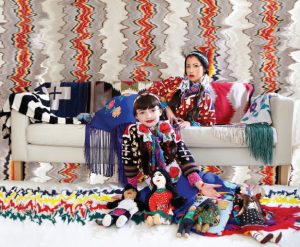
Wendy Red Star, Apsáalooke Feminist #3—Apsáalooke Feminist Series, 2016, on view at the Newark Museum through June 16th. Image: © Wendy Red Star
Legal Gender: The Irreverent Art of Anita Steckel
April 13 – May 12, 2019
Verge Center for the Arts, Sacramento
When artist Anita Steckel’s (American, 1930-2012) solo exhibition, The Sexual Politics of Feminist Art (1972, Rockland Community College) was threatened closure by a County Legislator due to the erotic imagery in her work, she founded the Fight Censorship Group. The women’s collective, including member artists Louise Bourgeois, Hannah Wilke, and Joan Semmel among others, denounced the double standard in the artistic community between sexualized men and women, and played a major role in reshaping thought around erotic subject matter within the context of sexual and creative freedom. This exhibit, curated by Kelly Lindner and Rachel Middleman, spans five decades of the feminist artist’s collage and appropriation artwork including the Mom Art photomontage series from the 1960s (the title playing on the recognized term “Pop Art”) incorporating found imagery of anonymous librarians and priests critiquing racism, war and sexual inequalities; the Giant Woman series of photomontage with graphite depictions of mammoth women taking over New York City landmarks; her last series reworking personal photographs of family and friends, and more. As the exhibit statement points out: “In her deft combinations of photomontage, collage, drawing, and painting, Steckel proposes a broader discussion of female sexuality, feminism, gender parity, racial injustice, and political reckoning.” The exhibit surely pushes art’s boundaries, even today, as in the artist’s own words: “Good taste is the enemy of art. It’s wonderful for curtains, but in art, it’s suffocating.”
Wendy Red Star: A Scratch on the Earth
February 23 – June 16, 2019
Newark Museum, New Jersey
A Scratch on the Earth is a mid-career survey held at the Newark Museum of Wendy Red Star, a multidisciplinary artist (b. 1981) from Montana and member of the Apsáalooke (Crow) Tribe, organized by Tricia Laughlin Bloom, Curator of American Art, and guest curator Nadiah Rivera Fellah. Red Star’s presentation, including installation, photography, photo-collage, textile, and mixed media, explores the visual, social, and racial history of indigenous Crow traditions and mythology, often intermixed with the tribe’s painful experiences during which it lost land ownership under colonial American policies. Red Star critically analyzes and researches the portrayal of Native American subjects in the nineteenth century, an imaginary representation of the American West and Indian Reservations manipulated and promulgated by the US government and Hollywood, and highlights the Crow’s manifold resistance to such geographical, political and gendered boundaries. Many of Red Star’s series, for example Map of the Allotted Lands of the Crow Reservation, Montana—A Tribute to Many Good Women (2016), foreground the Crow’s matriarchal and ceremonial legacies supplanted by government enforced patriarchal structures. Red Star playfully and powerfully utilizes photography in her Apsáalooke Feminist series as a contemporary vehicle to refashion “original” Crow Indian representations in Western art through the production of large scale self-portraiture and the exuberant display of her own young daughter, both dressed in elk-tooth attire. A well-illustrated catalogue with essays is published in conjunction with the exhibition.
Aleksandra Karpowicz: Body as Home
May 6 – September 15, 2019
Venice, inauguration of GAD – Giudecca Art District, Italy
Aleksandra Karpowicz’s Body as Home (2018), a three channel 15-minute film, will mark the official launch of Giudecca Art District (GAD), coinciding with the opening of the 58th Biennale Arte 2019 in Venice, Italy. It portrays a journey of three protagonists who discover their selves through their bodily interactions with space. They are captured in four urban locations: Cape Town, London, New York, and Warsaw, navigating complex relationships between their social identity, migration, and the understanding of the concept of “home.” Karpowicz, a migrant herself (born in Poland, living in London), complicates the latter beyond its literal meaning and associations with a dwelling or a place of habitation. She questions when one becomes a visitor or a local inhabitant; how this is conditioned by movement, going away, towards or from and to. The artist is interested in the feeling of “being at home” in relation to geographical locations, to other people but also the self.
Still I Rise: Feminisms, Gender, Resistance, Act 2
February 9 – May 27, 2019
The De La Warr Pavilion, Bexhill-on-Sea, UK
Still I rise, with Act 1 presented at Nottingham Contemporary in Nottingham UK at the end of 2018 and beginning of 2019, and Act 2 now on display in The De La Warr Pavilion, UK, is a powerful exhibition featuring works of over 40 practitioners, including for example Carolina Caycedo, Barby Asante, Tai Shani, Osias Yanov or Glenn Belverio (Glennda Orgasm), among many others. They are grounded in intersectional and queer feminist perspectives in a global context. The exhibition explores ways in which resistance has been approached and enabled through associated with feminism and feminist protest principles of collaboration, mutual support, community building, empathy, nurture, and solidarity. The title references Maya Angelou poem Still I rise (1978), concerning oppression and the struggle to overcome prejudice and injustice, which begins:
‘You may write me down in history
With your bitter, twisted lies,
You may trod me in the very dirt
But still, like dust, I’ll rise.’
Diverse creative practices on display navigate and suggest alternative ways of living and being together that are respectful of human rights and equality.
Jeschkelanger: #siostrzane_odbicie (#sister’s_reflection)
May 15 – June 23, 2019
SiC! Biuro Wystaw Artystycznych (Glass and Ceramics Gallery), Wrocław, Poland
The exhibition features glass work of two artists from Germany, who in December 2016 founded the artist duo Jeschkelanger. They work across multiple media, however they connect through glass, which acts as a space of exploration, collaboration, and exchange of ideas. Jeschkelanger question its limits and possibilities as a material, a medium, a method, and what they call “a melting point,” “a danger zone” and “a contact zone.” The works featured in this exhibition address the concept of hospitality and suggest ways in which the other may be welcome, while acknowledging difference and enabling mutual exchange, and where the dynamics between the host and the guest are questioned. Jeschkelanger create space for a future of shared mutual respect and connectivity, embodying feminist principles of solidarity and friendship. Their vision is hopeful and inviting the politics of togetherness.
THE UNEXPECTED SUBJECT: 1978 ART AND FEMINISM IN ITALY
April 4 – May 26, 2019
FM Center for Contemporary Art, Milan
Curators Marco Scotini and Raffaella Perna selected the year 1978 as “the catalyst year of all energies in play (not only in Italy)” to develop this broad investigation and “reconstruction of the relationship between visual arts and feminist movement in Italy” and the exchanges of feminist artists in Italy at this time with artistic panorama of Europe and beyond. The exhibit will include work from artists included in the 1978 Venice Biennale—which counted 80 women at a time when entrance was difficult—including the visual poetry of Mirella Bentivoglio (1922-2017) among others. The exhibit description names several notable exhibitions that took place in 1978 including an exhibition dedicated to Ketty La Rocca (1938-1976), a leading figure of Italian neo-avant-garde; the first feminist exhibit in Wroclaw, Poland, First International Women’s Art Exhibition; Coazione a Mostrare and Magma, which presented many significant European artists including Marina Abramovic, Hanna Darboven, Gina Pane, VALIE EXPORT, Rebecca Horn, Natalia LL among others. The year also included the international feminist seminar Comrade Woman: Women’s Question—A New Approach? in Belgrade; and the Cooperative Beato Angelico in Rome, the first artistic space entirely run by women. Though most of these notations include the word woman, the description notes the exhibition “criticizes the mainstream historical-critical view that relegates women artists to a marginal position” and privileges “artworks that demystify gender stereotypes and reflect on the role of women in society” including loaned artwork and printed materials related to feminist movements—posters, fanzines, LPs, photographs, and books.
LIKE SUGAR
February 9 – June 23, 2019
Tang Museum, Saratoga Springs, New York
Sugar is all around us, from harvest to consumer product, playing a role in several social justice issues from slavery to ecology and health epidemics and food injustice. Like Sugar explores these both positive and negative aspects of the sweet-tasting, soluble carbohydrates through contemporary artwork, historical materials and material culture. Viewing Emily Eveleth’s both delicious and engorged Big Pink (2016), enlarged pink frosted donuts in oil on canvas, in the same space as 19th-century stereoscopic images depicting slaves in sugar cane fields, such as Preparing Cane Blocks for Replanting, St. Kitts, immediately provokes thought and discussion around sugar in our lives in the present and past. Other artists in the exhibition include Julia Jacquette, Zine Sedira, and Laurie Simmons.
Mickalene Thomas: Do I Look Like a Lady?
March 9 – August 31, 2019
Portland Art Museum
Artist Mickalene Thomas is well-known for her photography, installation, and more recently film production reconsidering black womanhood through a queer lens. The Portland Art Museum just acquired the video installation, Do I Look Like a Lady (Comedians and Singers) (2016), the first by the artist in their collection. The video displays in checkerboard format, moving image footage and individual voices of African-American actors and singers from the 20th century such as Eartha Kitt, Jack “Moms” Mabley, Whoopi Goldberg, and Whitney Houston among others. They express heartbreaking roles, pointed lyrics, sharp jokes, and strong statements of resistance to the dominant culture offering a strong, rebellious, and poignant consideration of the roles of black women in the United States. The museum notes that Thomas spent time in Portland as a young adult and while there admired an exhibition of Carrie Mae Weem’s work in 1994, which was a formative experience that led her to becoming an artist.
Serve on Professional Development Fellowship Juries
posted by CAA — Apr 22, 2019
CAA invites nominations and self-nominations for individuals to serve on our Professional Development Fellowship juries for three years (2019–22). Terms begin July 2019.
JURY VACANCIES FOR SPRING 2019
- Professional Development Fellowship in Visual Art: two members
- Professional Development Fellowship in Art History: one member
Duties and Qualifications
The fellowship juries award $10,000 each to one visual artist completing an MFA and one art historian completing a PhD in the coming year. Candidates for the art history jury must be actively publishing scholars with demonstrated seniority and achievement; candidates for the visual arts jury must be actively producing artists with a track record of exhibitions. Institutional affiliation is not required. Jury members review applications once per year and confer by conference call.
Candidates must possess expertise appropriate to the jury’s work and be current CAA members. They should not hold a position on a CAA committee or editorial board beyond May 31, 2019. CAA’s president and vice president for committees appoint jury members for service.
HOW TO APPLY
Nominations and self-nominations should include a brief statement (no more than 150 words) outlining the individual’s qualifications and experience and a CV (an abbreviated CV no more than two pages may be submitted). Please send all materials by email to Cali Buckley, CAA grants and special programs manager; submissions must be sent as Microsoft Word or Adobe PDF attachments.
For questions about jury service and responsibilities, contact Tiffany Dugan, CAA director of programs and publications.
Deadline: May 13, 2019
Affiliated Society News for April 2019
posted by CAA — Apr 11, 2019
Affiliated Society News shares the new and exciting things CAA’s affiliated organizations are working on including activities, awards, publications, conferences, and exhibitions.
WELCOME TO NEW AFFILIATED SOCIETIES
We are delighted to welcome the following organizations to CAA:
- Digital Art History Society
- William Morris Society in the United States
- International Council of Fine Arts Deans
- Association of Scholars of Christianity in the History of Art
- Association of Greek Art Historians
- Society for the History of Collecting
Interested in becoming an Affiliated Society? Learn more here.
Historians of German, Scandinavian, and Central European Art and Architecture (HGSCEA)
HGSCEA was well represented at CAA by members who presented papers and chaired sessions, and whose latest publications could be found in the book exhibition. Of particular note was our sponsored session, “Women Artists in Germany, Scandinavia, and Central Europe, 1880-1950,” chaired by Kerry Greaves. Her introductory remarks and concluding comments framed four excellent papers by Emil Leth Meilvang on Rita Kernn-Larsen, Nora Butkovich on women in the Young Yiddish Group in Poland, Lauren Hanson on Mary Bauermeister, and Lynette Roth on Anneliese Hager. On the conference’s last day, Paul Stirton offered members a special tour of the exhibition “Jan Tschichold and the New Typography,” which he curated at Bard Graduate Center.
Over sixty members, many in metallic attire for the Bauhaus centenary, attended the annual dinner. In the course of the convivial evening, the results of the 2018 Emerging Scholars Prize were announced. Anne Reimers (University of the Creative Arts Rochester, UK) received an honorable mention for “Inscribing Temporality, Containing Fashion: Otto Dix’s Portrait of the Dancer Anita Berber Contextualized,” in Art History. The winner was Greg Bryda (Barnard College), who was awarded the prize for “The Exuding Wood of the Cross at Isenheim,” in The Art Bulletin. In addition, we celebrated the achievements of Maria Makela on the occasion of her retirement. Adrian Sudhalter spoke to the impact of Maria’s scholarship, and Ricki Washton-Long reflected on her important contributions to HGSCEA.
At the business meeting, the Board amended the bylaws to ensure that in the future the Board includes representatives from all three areas that constitute HGSCEA. It also deliberated on the pool of submissions for the guaranteed session at the 2020 conference, accepting the proposal of Hyewon Yoon and Jordan Troeller, “A Foreign Eye: Photography, Women, and Global Encounters in the Twentieth Century.”
For pictures of the session, dinner, and curator’s tour, go to: http://hgscea.org/
National Council of Arts Administrators
- NCAA welcomes three new board members, Jonathan Fohrman, MiraCosta College, CA, Sarah Meyer, California Poly Pomona, and Michael Wille, Illinois State University to the NCAA Board of Directors.
The current list of board members include:
Lynne Allen, Boston University
President
Elissa Armstrong, Virginia Commonwealth University
Past President
Peter Chametzky, University of South Carolina
Secretary
Cathy Pagani, The University of Alabama
Treasurer
Andrea Eis, Oakland University
Past Treasurer
Colin Blakely, University of Arizona
Jeni Mokren, SUNY New Paltz
A.Blake Pearce, Valdosta State University
Joe Poshek, Irvine Valley College
Michael Fels, Elon University
Jade Jewett, California State University, Fulteron
David LaPalonbara, Ohio University
- The next NCAA conference will be hosted by Kate Bonansingakn, University of Cincinnati, Matt Albritton, Northern Kentucky University and Paige Williams, Art Academy of Cincinnati. We hope to see everyone in Cincinnati September 17-22,2019! Check it out on our website.
- It is with great pleasure that we open our NEW website which offers news of the upcoming conference, current open positions, and access to other resources. Please check it out https://www.ncaaarts.org
Association for Latin American Art

ALAA Reception at Orange Door Chicago (Marilynn and Carl Thoma Gallery). Pictured left to right: Marilynn Thoma, Erin Fowler (Director of Strategic Initiative, Thoma Art Foundation), Delia Cosentino (Triennial Chair)
The Association for Latin American Art hosted its 5th Triennial Conference “The World Turned Upside Down: Arts of Oppression and Resistance in the American Hemisphere” from March 7-9, 2019 at the Art Institute of Chicago and DePaul University. In addition to a wonderful selection of panels, the conference included tours of the Smart Museum’s holding of Latin American art at the University of Chicago and the exhibition Super/Natural: Textiles of the Andes at the Art Institute of Chicago, a keynote lecture “Social Disequilibria: of Bodies and Borders” by Dr. Adriana Zavala, Tufts University, at the National Museum of Mexican Art, and a reception at the Orange Door Chicago (Marilyn and Carl Thoma Gallery). https://associationlatinamericanart.org/triennial/

Art Institute of Chicago’s Elizabeth Pope & Erica Warren Tour of Super/Natural: Textiles of the Andes
Appraisers Association of America
15th Annual Award Luncheon honoring cultural anthropologist, author and museum director Johnnetta Betsch Cole, Ph.D., and visual artist Mickalene Thomas, whose work of African American women examine, extend, and subvert concepts of female identity and beauty.Dr. Cole and Ms. Thomas will be presented with the 2019 Award for Excellence in the Arts on Wednesday, April 17, 2019 at the New York Athletic Club.
For tickets and sponsorship opportunities please click here. Or by calling 212-889-5404 x11.
ASSOCIATION FOR TEXTUAL SCHOLARSHIP IN ART HISTORY (ATSAH)
Announcement Award
Prof. Damiano Acciarino, Univerisità Ca’ Foscari Venezia and University of Toronto, who holds A Marie Curie Global Fellowship (2017-2020) was the first recipient of ATSAH award for his innovative and scholarly research on Renaissance antiquarianism published in Lettere sulle Grotteche (Rome: Aracne, 2018).
Professional Recognition
Liana De Girolami Cheney, President of ATSAH, received the Albert Nelson Marquis Lifetime Achievement Award
William Levin contributes a second award to SECAC for scholarly Research in the History of Art Since 1750. The previous award was for Research in the History of Art Before 1750.
Member’s publications
Sara Nair James. “Wit and Humor in Ugolino di Prete Ilario’s Life of the Virgin at Orvieto,” Source: Notes in the History of Art vol 36, no.3-4 (Spring/Summer 2017), 159-67.
Davide Lacagnina, “Spreading Visual Culture: revues, images et archives pour l’art contemporain,” In H.V. E. Stead, ed L’Europe des revues II (1860-1930). Réseaux et circulations des modèles (PARIS: PUPS-Presses de l’université Paris-Sorbonne, 2018), pp. 829-852.
Émilie Passignat, “‘Manière’, ‘maniéré’, ‘maniériste’: transferts et enjeux théoriques autour d’un terme clé du vocabulaire artistique”, in M.-C. Heck, M. Freyssinet, S. Trouvé (eds.), Lexicographie artis- tique: formes, usages et enjeux dans l’Europe moderne, Montpellier, 2018, pp. 363-376.
Liana De Girolami Cheney, “Il Tesoretto of Cosimo I de’ Medici: An Esoteric Heaven,” in Lilian Zirpolo, ed. Esoteric Traditions and Their Impact on Art (Ramsey, NJ: Zephyrus Scholarly Publications LLC, 2019) (ISBN number: 978-0-997-2446-2-5)
Liana De Girolami Cheney, “Edward Burne-Jones’s The Mirror of Venus: Physical and Intangible Female Beauty,” Journal of Literature and Art Studies, Vol. 19, No. 1 (January 2019):1-28.
IN MEMORIAM (April 29, 2019)
Sarah Jordan Lippert (1975-2019), Associate Professor of Art History at the University of Michigan-Flint, Director of the Society for Paragone Studies, Editor-in-Chief of its journal Paragone: Past and Present passed away on April 24, 2019. She was the author of numerous books and articles including the newly published The Paragone in Nineteenth-Century Art (Routledge 2019), along with Going Back to the Beginning of Things: The Ancient Origins of the Arts of France (Taylor and Francis, UK 2018), and The Temporality of Imitation in the Works of Moreau and Gérome (Tauris, UK, 2017): https://umflint.academia.edu/SarahLippert/Books
Sarah was long-time supporter and member of ATSAH, SECAC and CAA.
The SECAC 2019 session in Chattanooga, she was to chair at the upcoming conference, The Art of Depicting Paragoni of Life, will go forward in honor of her memory as well as special session at CAA in 2020
We are grateful to have known and loved this young, energetic, and accomplished scholar. ATSAH plans to establish an academic fund in her honor. Details will follow.
American Institute for Conservation
We are proud to announce that we have launched a new name, look, and message for AIC and FAIC! The American Institute for Conservation of Historic and Artistic Works is now simply the American Institute for Conservation. The foundation is now the Foundation for Advancement in Conservation. The acronyms are the same, but our message is more direct: we preserve and protect cultural heritage. We’re reinforcing this message with a new online presence: www.culturalheritage.org. AIC President Margaret Holben Ellis explains the necessity of our new identity in this video. We welcome you to explore our new online presence and let us know what you think. You can provide feedback via email to info@culturalheritage.org.
Throughout this process, we considered how we could make our field more welcoming and engaging to all practitioners in the arts, humanities, and allied professions. We would like to invite everyone to learn more about conservation and support the essential work performed by conservators and preservation professionals. Friends of Conservation receive exclusive insights into conservation while sustaining programs that promote the preservation of cultural heritage through their gift to FAIC. Learn about the benefits of being a Friend and how you can help support the work of conservators here: www.culturalheritage.org/friends.
Women’s Caucus for Art
Call for Panel Proposals at CAA
Women’s Caucus for Art invites submissions for a panel to be held at the CAA conference in Chicago. WCA hosts a conference concurrent with CAA, with some panels happening on site at CAA, and our 2020 theme is Intersectionality. Sessions are 90 minutes and may take the form of panels or roundtable discussions. We welcome submissions of topics for an open call as well as submissions with panel participants already identified.
To apply, please send panel title, 250-word abstract, and short CV to WCA President Margo Hobbs, at margohobbs@muhlenberg.edu
Proposals are due April 21, 2019. Selections will be made by the WCA Executive Board and the Conference Committee. Applicants will be notified of decisions by April 28, 2019.
Digital Art History Society
The new Digital Art History Society (DAHS), launched on January 1, 2019, inspired by “Art History in Digital Dimensions,” hosted in October 2016 by the Department of Art History and Archaeology and the Maryland Institute for Technology in the Humanities (MITH), University of Maryland, College Park, with support from the Getty Foundation and the Samuel H. Kress Foundation (see: http://dah-dimensions.org/).
The Digital Art History Society (DAHS) supports art historical scholarship incorporating and benefitting from digital strategies and technologies. Its website (https://digitalarthistorysociety.org) and listserv promote communication about resources and opportunities for its members. Membership in 2019 is free; dues will subsequently increase to $25.00 to defray administrative costs.
DAHS presented “Constructing Criticality in Digital Art History,” at CAA’s 2019 meeting (https://caa.confex.com/caa/2019/meetingapp.cgi/Session/2249.) Its 2020 session will examine new scholarship enabled by digital techniques and strategies. DAHS looks forward to collaborating with other CAA Affiliates.
Founding Board: President, Anne Collins Goodyear; Vice President for Programming: Pamela Fletcher; Vice Presidents for Outreach: Deena Engel and Charles R. Johnson; Vice Presidents for Membership: Meredith Gill and Paul Jaskot; Vice Presidents for Communications: Jennifer Henel and Ellen Prokop; Treasurer: Anne Helmreich.
Upcoming events (free,but online registration is required. Please visit frick.org/programs/library to register. Meet at 1 East 70th Street, NYC):
Lecture: “Artist Archives Initiative: New Research Models for Contemporary Artists,” Thursday, May 2, 4:00 p.m. to 6:00 p.m. The Frick Collection and Frick Art Reference Library, New York. Deena Engel, Clinical Professor, Computer Science, NYU, and Glenn Wharton, Clinical Professor, Museum Studies, NYU.
Workshop: “The Lenox Library Picture Gallery: A Digital Recreation,” Wednesday, June 5, 4:00 p.m. to 6:00 p.m. The Frick Collection and Frick Art Reference Library, New York. Sally Webster, Professor Emerita, Lehman College and the Graduate Center, CUNY, and David Schwittek.
Midwest Art History Society
The Midwest Art History Society (MAHS) recently concluded its annual conference in Cincinnati where participants were warmly welcomed by local institutions — especially the Cincinnati Museum of Art (CAM) and the Taft Museum of Art which both hosted scholarly sessions. The keynote lecture was delivered by S. Hollis Clayson, Bergen Evans Professor in the Humanities at Northwestern University, in association with CAM’s exhibition Paris 1900: City of Entertainment featuring works drawn from the collections of the City of Paris museums. At the annual business meeting, Erica Warren, Art Institute of Chicago, was elected the organization’s treasurer. Plans are well underway for the 2020 annual conference which will be held in Houston, March 19-21. The call for papers will be posted on the MAHS website in the fall and hotel rooms can already be reserved at the Magnolia Hotel Houston. For more information, please visit the website at www.mahsonline.org.
SECAC
SECAC 2019, Chattanooga, TN, October 16-19: The 75th annual SECAC Conference will take place in Chattanooga, Tennessee, October 16-19. The conference will include more than 130 sessions exploring topics of scholarly importance and timely cultural issues impacting the fields of art history, art education, graphic design, and studio art. SECAC 2019 will examine the place of the institution amongst current political turmoil, explore studio and art historical research related to parenthood, develop strategies for supporting each other, and unpack how designers engage with their communities, amongst dozens of other topics. The Chattanoogan will serve as the conference hotel and hub, located in the heart of downtown and steps away from many cafes, restaurants, and attractions. Beyond conference sessions, opportunities to come together and experience the city will include a keynote address by Sharon Louden, visual artist and Artistic Director of Chautauqua Institution’s Visual Arts Program, at the Hunter Museum of American Art and the SECAC Juried Members and Artist Fellowship exhibitions, juried by visual artist and curator Amelia Briggs and presented with Stove Works, a new residency program and exhibition space located in Chattanooga. See https://secacart.org/page/Chattanooga for more information.
Levin Awards for Research in Art History: Inspired by the friendships, professional advancement, and opportunities for exchange of scholarly research that SECAC supports, William R. Levin has made a second major gift to SECAC. Beginning in 2019, SECAC will award two $5,000 research grants in art history each year. The original Levin Award (2014) will be designated for Research in the History of Art Before 1750 and the new Levin Award will be for Research in the History of Art Since 1750.
SECAC at CAA: Below the Mason-Dixon Line: Artists and Historians Considering the South, organized by Rachel Stephens of the University of Alabama, featured five presentations: Naomi Slipp’s paper, “Between Two Worlds: Portrait of William McIntosh, Southern Slave Owner and Lower Creek Chief;” Jeremiah Ariaz on photographs from his volume, The Louisiana Trail Riding Clubs; Catherine Wilkins and Jared Ragland on Ragland’s wet-plate collodion project, “Where You Come From is Gone;” artist Kristin Casaletto on the impact of living in the South on her work; and Nell Gottlieb on her ongoing project on returning to her Southern roots, “Nostos Algos.”
In memoriam: SECAC mourns the passing of Past-President Charles (Randy) Mack. Mack joined SECAC in 1970 and played an active role in the organization for 35 years, serving twice as president (1975-76, 2003-05), as vice-president (2000-03), and as board member from 1984-90. He also co-edited the SECAC Review (1973-75) and chaired the Annual Conference (1976). In 1993, he received SECAC’s Award for Outstanding Exhibition and Catalogue of Historical Materials; in 1998, he was the recipient of the Annual Award for Scholarly Research and Publication; and in 2004, he received SECAC’s highest honor, the Award of Distinction.
Society of Historians of Eastern European, Eurasian, and Russian Art and Architecture (SHERA)
The board of the Society of Historians of Eastern European, Eurasian, and Russian Art and Architecture (SHERA) is pleased to announce the inauguration of the SHERA Graduate Student / Independent Scholar Research Grant. The grant of $500 will be awarded to one member for research and/or study toward the completion of a thesis, dissertation, or publication. The grant is intended to be used toward the cost of research travel or accommodations, the acquisition of image rights for publication, language study, and other related activities. For the 2019 competition, applications are limited to graduate students and scholars who do not hold a full-time position at an academic institution. Applicants must be SHERA members in good standing and must have membership in the organization for at least two consecutive years. For more information, see the notice here.
The conference “Eclecticism at the Edges: Medieval Art and Architecture at the Crossroads of the Latin, Greek, and Slavic Cultural Spheres c.1300–c.1550,” of which SHERA was a sponsor, was held at Princeton University on April 5 and 6. The symposium, organized by Dr. Alice Isabella Sullivan, Ph.D. (University of Michigan) and Dr. Maria Alessia Rossi, Ph.D. (The Index of Medieval Art, Princeton University), is the first such initiative to explore, discuss, and focus on the art, architecture, and visual culture of regions of the Balkans and the Carpathians (c.1300-c.1550). The conference sought to raise issues of cultural contact, transmission, and appropriation of western medieval, byzantine, and Slavic artistic and cultural traditions in eastern European centers and consider how this heritage was deployed to shape notions of identity and visual rhetoric in these regions from the fourteenth through the sixteenth centuries. Dr. Jelena Erdeljan of the University of Belgrade delivered the keynote address.
ACASA
- In Memoriam: Marshall Ward Mount (1927-2018). Tribute by Perrin Lathrop can be found here: https://www.acasaonline.org/in-memoriam-marshall-ward-mount-1927-2018/
Donations may be made in Marshall Ward Mount’s memory to the African Wildlife Fund.
- In Memoriam: Christopher Damon Roy (1947-2019). Tribute by Cory Gundlach can be found here: https://www.acasaonline.org/tribute-to-professor-christopher-damon-roy-1947-2019/
To contribute to the Christopher D. Roy Memorial Fund, go to //www.givetoiowa.org/2019la98. This fund will give UI art history students the opportunity to gain valuable intern experience at the Stanley Museum of Art.
- In Memoriam: Bisi Silva (1962-2019). Tribute by Dr. Peju Layiwola can be found here: https://www.acasaonline.org/in-memoriam-bisi-silva-1962-2019/
- Congratulations to ACASA board member Shadreck Chirikure (Professor, Department of Archaeology at the University of Cape Town) who received a British Academy Professorship in the School of Archaeology at Oxford and will be joining the School in 2019. Dr Chirikure will be researching archaeometry and precolonial African urban social formations. Shadreck Chirikure’s Archaeological Materials Laboratory is Africa’s only facility dedicated to the study of pyrotechnology practiced by farming communities of the last 2000 years of the sub-Saharan past. The announcement can be found here: https://www.arch.ox.ac.uk/article/british-academy-global-professorship-awarded-dr-shadreck-chirikure
- Congratulations to ACASA member Ugochukwu-Smooth C. Nzewi on his appointment as the first Steven and Lisa Tananbaum Curator in the Department of Painting and Sculpture at the Museum of Modern Art. He was also recently elected to the College Art Association Board of Directors. The MOMA announcement can be found here: https://www.culturetype.com/2019/03/07/ugochukwu-smooth-c-nzewi-appointed-curator-in-painting-and-sculpture-department-at-museum-of-modern-art/
- Congratulations to ACASA member Huey Copeland (Assoc. Professor, Northwestern University) on recently being awarded the 2019 David C. Driskell Prize by the High Museum of Art in Atlanta. He will be honored on April 26 at a celebratory dinner at the museum. The announcement can be found here: https://www.culturetype.com/2019/02/04/high-museum-of-art-awards-2019-david-c-driskell-prize-to-scholar-huey-copeland/
New in caa.reviews
posted by CAA — Apr 05, 2019
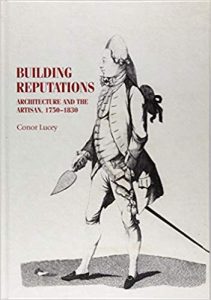
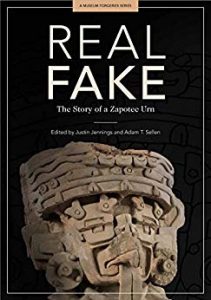 Nancy Kellar discusses Real Fake: The Story of a Zapotec Urn, edited by Justin Jennings and Adam T. Sellen. Read the full review at caa.reviews.
Nancy Kellar discusses Real Fake: The Story of a Zapotec Urn, edited by Justin Jennings and Adam T. Sellen. Read the full review at caa.reviews.
Carl Lounsbury writes about Building Reputations: Architecture and the Artisan, 1750–1830 by Conor Lucey. Read the full review at caa.reviews.



